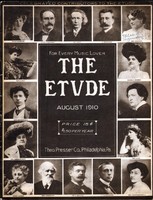BY DR. ANNIE PATTERSON.
Fingering presents a very real difficulty to the pianoforte student, even at advanced stages of his practice. Teachers' systems of fingering also differ, which still further complicates the problem. Indeed, the learner soon finds that he has, sooner or later, to be a law to himself in this matter, as the fingering that assists one hand is awkward or even impossible for another. A few general principles, therefore, on the art of neat and legitimate fingering of the keyboard, may be of help, especially to the self-taught.
If a child, or inexperienced player, tries to read a piece at first sight, almost invariably the first and second fingers are used nearly to the complete exclusion of the thumb, with the third and fourth fingers. This is simply the result of the natural formation of the hand which gives greater strength to the index and middle fingers.
Until J. S. Bach's day, it would appear that the thumb was not used at all, and, for a considerable time, it was never placed on the black keys. With the advent of Chopin's music, and the demand which it made upon the executive qualities of the hand, all the fingers, including the thumb, were brought into play. Early technical exercises, for this reason, require to be directed to give an equal strength of attack to all fingers. Until this be acquired, even and easy fingering is out of the question.
Having, thus, five fingers, every one of which may be utilized, the point is so to spread them out that no one digit shall bear a greater burden of work than its neighbor. In other words, each consecutive series of five notes in a melodic passage, ascending or descending, should be "covered" by the hand. This entails getting into the habit of "looking ahead," so as to see what kind of a passage is coming. This faculty, needless to say, only comes with practice. The hand thus getting into the habit of lying over certain sections of notes which it has to play, naturally assumes a tranquil pose which, with care, is not displaced by turning under or over the thumb. From point to point in ascending and descending series of scale passages, the thumb ever makes a bridge, whereby the hand may shift its position to the best advantage.
As to where the turn over or under may best be effected, the principle generally followed in scale-playing is applied in practice in melody-playing. Thus, in ascending themes, a turn under with the thumb is made after the limits of the second or third finger is reached, preferably the second. In descending, when the hand is used up, so to speak, and comes to a dead stop once the thumb is reached, either third or second fingers should be turned over as the passage may demand. In short, the hand should use the thumb for a bridge when, without being bodily raised, it can itself proceed no further. Similarly, in chord and arpeggio playing, the hand should so spread itself that each note has the most suitable finger devoted to it. The changing of fingers, as in organ playing, requires special adriotness (sic), but comes easily with practice.
"The meaning of music goes deep, a kind of inarticulate unfathomable speech, which leads to the edge of the infinite, and lets us for a moment gaze into that."—Carlyle.



